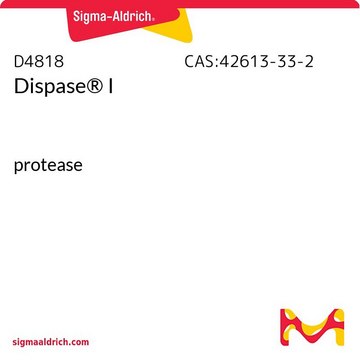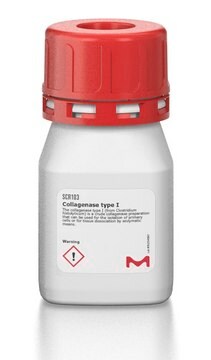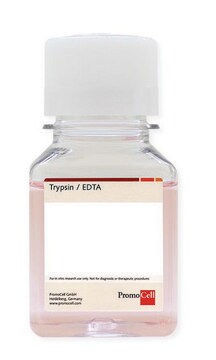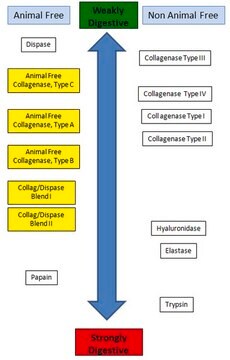04942086001
Roche
Dispase® I (neutral protease, grade I)
lyophilized, ≥10 units/mg protein (20 U/vial (37 °C, casein as substrate, pH 7.5)), optimum pH 6.0-8.5
About This Item
Produits recommandés
Source biologique
Bacillus polymyxa
Niveau de qualité
Forme
lyophilized
Activité spécifique
≥10 units/mg protein (20 U/vial (37 °C, casein as substrate, pH 7.5))
Conditionnement
pkg of 10 × ~2 mg
Fabricant/nom de marque
Roche
Concentration
0.6-2.4 U/mL
Technique(s)
tissue processing: suitable
Couleur
white
pH optimal
6.0-8.5
Solubilité
water: soluble
Application(s)
life science and biopharma
sample preparation
Conditions d'expédition
wet ice
Température de stockage
2-8°C
Description générale
Spécificité
Application
Caractéristiques et avantages
- Rapid, effective, yet gentle agent that liberates intact cells
- Maintains cell membrane integrity
- Non-mammalian source - free of mycoplasma and animal virus contamination
- Extremely stable to influences of temperature, pH, and interference by serum components
- Easily inactivated by chelating agents or by dilution
- Delivers higher activity and convenience
Contents
10 vials with approximately 2mg each (= 20U/vial).
Caractéristiques
Inhibitors: EDTA, EGTA, Hg2+, other heavy metals. Dispase is not inhibited by serum.
Définition de l'unité
A practical comparison of RAS units of Dispase® with those cited in the Japanese literature (where concentrations of 1,000 to 2,000 Dispase® units /ml are not uncommon) suggests one Roche Applied Science unit of Dispase® I equals approximately 416 Japanese units of Dispase®.
One unit of Roche Applied Science Dispase® equals 181 protease units (PU) measured as release of amino acids equivalent to 1 μg tyrosine per min and ml at pH 7.5 and +37 °C.
Forme physique
Notes préparatoires
Working concentration: 0.6 to 2.4 U/ml
Working solution: Preparation of stock and working solutions:
To produce a 10 mg/ml stock solution, dissolve the lyophilized Dispase® I enzyme in HEPES-buffered saline (50 mM HEPES/KOH pH 7.4, 150 mM NaCl). To produce the working solution, dilute the above stock solution with the culture medium for the isolated cells, at a final concentration of 0.6 to 2.4 U/ml. Note that concentrations higher than 2.4 U/ml are not recommended. For best results, filter the working solution using a 0.22 μm filter membrane.
Storage conditions (working solution): -15 to -25 °C
The reconstituted stock solution is stable at 2 to 8 °C for 2 weeks. For storage up to 2 months, the stock solution should be frozen in aliquots. Avoid repeated freezing and thawing.
The working solution diluted with PBS is stable at 2 to 8 °C for 3 days.
Stockage et stabilité
Autres remarques
Informations légales
Mention d'avertissement
Danger
Mentions de danger
Conseils de prudence
Classification des risques
Eye Irrit. 2 - Resp. Sens. 1 - Skin Irrit. 2 - STOT SE 3
Organes cibles
Respiratory system
Code de la classe de stockage
11 - Combustible Solids
Classe de danger pour l'eau (WGK)
WGK 1
Point d'éclair (°F)
does not flash
Point d'éclair (°C)
does not flash
Certificats d'analyse (COA)
Recherchez un Certificats d'analyse (COA) en saisissant le numéro de lot du produit. Les numéros de lot figurent sur l'étiquette du produit après les mots "Lot" ou "Batch".
Déjà en possession de ce produit ?
Retrouvez la documentation relative aux produits que vous avez récemment achetés dans la Bibliothèque de documents.
Les clients ont également consulté
Articles
Enzyme Explorer Key Resource: Collagenase Guide.Collagenases, enzymes that break down the native collagen that holds animal tissues together, are made by a variety of microorganisms and by many different animal cells.
Enzyme Explorer Key Resource: Collagenase Guide.Collagenases, enzymes that break down the native collagen that holds animal tissues together, are made by a variety of microorganisms and by many different animal cells.
Contenu apparenté
Collagenase Guide.Collagenases, enzymes that break down the native collagen that holds animal tissues together, are made by a variety of microorganisms and by many different animal cells.
Notre équipe de scientifiques dispose d'une expérience dans tous les secteurs de la recherche, notamment en sciences de la vie, science des matériaux, synthèse chimique, chromatographie, analyse et dans de nombreux autres domaines..
Contacter notre Service technique
















